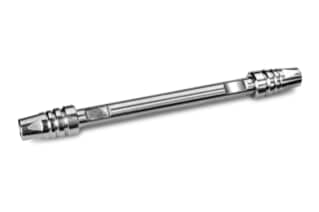
|
Chemistry |
Amide |
|
Separation Mode |
Hydrophilic Interaction (HILIC) |
|
Particle Substrate |
Hybrid |
|
pH Range Min |
2 pH |
|
pH Range Max |
11 pH |
|
Maximum Pressure |
18000 psi (1240 Bar) |
|
Endcapped |
Yes |
|
Silanol Activity |
Low |
|
Particle Shape |
Spherical |
|
Particle Size |
2.5 µm |
|
Endfitting Type |
Parker-style |
|
Pore Size |
130 Å |
|
Format |
Column |
|
Surface Area |
185 |
|
System |
UHPLC, UPLC |
|
Particle Technology |
BEH |
|
USP Classification |
L68 |
|
Inner Diameter |
3 mm |
|
Length |
150 mm |
|
Carbon Load |
12 % |
|
eCord |
Yes |
|
UNSPSC |
41115709 |
|
Brand |
XBridge |
|
Product Type |
Columns |
|
Units per Package |
1 pk |
XBridge BEH Amide XP Column, 130Å, 2.5 µm, 3 mm X 150 mm, 1/pk
Based on Waters’ novel ethylene bridged hybrid (BEH) particle, XBridge BEH Amide XP Columns utilize a chemically stable, trifunctionally bonded amide phase that has enabled a new dimension of stability and versatility in HILIC separations. By offering the same selectivity as ACQUITY UPLC BEH Amide columns, scientists are able to use these columns to transfer separations between HPLC and UPLC technology platforms.
These columns have been designed to retain polar analytes and metabolites that are too polar to retain through reversed-phase chromatography, facilitating the use of a wide range of mobile phase (2-11) to enable to exceptional retention of polar analytes spanning a wide range in polarity, structural moiety, and pKa. In addition, XBridge BEH Amide XP Columns provide increased mass spectrometry response, direct compatibility with sample preparation eluates (PPT, LLE, and SPE), along with orthogonal selectivity compared to reversed-phase materials. This allows HILIC to be an attractive alternative separation technique.
As the most abundant and diverse class of compounds analyzed through HILIC, a range of carbohydrates (monosaccharides, polysaccharides, disaccharides, oligosaccharides) are able to be analyzed using XBridge BEH Amide XP Columns. The increased chemical stability allows for the use of high pH and high temperatures to collapse anomers without the loss of reducing sugars. Unlike amine-based lab equipment, these columns are not susceptible to Schiff base formation, improving quantitation accuracy.
The combination of BEH particle technology and trifunctionally bonded amide phases provides exceptional column lifetimes, improving assay robustness. Lifetimes can be improved even further through the use of an XBridge BEH Amide XP VanGuard Cartridge, 130Å, 2.5 µm, 2.1 mm X 5 mm, 3/pk.
What Information Is Included With XBridge BEH Amide XP Columns?
Each column includes a Certificate of Analysis specific to the batch of packing material, including the gel batch number, analysis of unbonded particles, and chromatographic results and conditions. A Performance Test Chromatogram is also included, which is specific to each individual column, including the gel batch number, column serial number, USP plate count, USP tailing factor, retention factor, and chromatographic test conditions. These data points should be recorded and stored for future reference, or they can be accessed via the ACQUITY UPLC console.